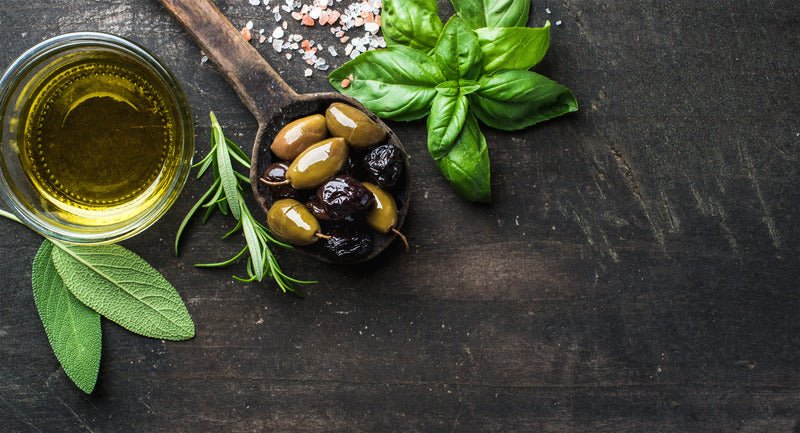Green and purple, black and brown, stuffed or plain, olives come in a wide variety. Let's explore the olive and learn more about this delicious Mediterranean treat.
What is an olive?
An olive is actually a fruit that grows on a tree. A stone fruit, or a drupe, to be exact, which is similar to other stone fruits like mangos, apricots, plums, peaches, and cherries. The term “stone” refers to the pit, which is the seed of this type of fruit.
It’s not a fruit that you can pick off the tree and eat, though. Fresh olives are really bitter! They have to go through a process of brining, which is curing in brine (very salty water), vinegar, or drying in salt to make them tasty.
The reason they’re so bitter is that the plant produces a chemical called oleuropein to discourage birds and other animals from eating the fruit. There are lots of plants that produce chemicals like this. It’s called a phytochemical, and plants use them for survival.
How did we get the olives we have today from the not-so-tasty fruit?
No one is certain who discovered that, with a little bit of a salt bath, olives are quite yummy. According to lore, olives growing by the Mediterranean Sea fell off the tree and into the water. The fruits were discovered and eaten after they’d been soaking for a while. The accidental brining proved to be the perfect treatment for the bitter fruit.

While soaking olives in a salt bath is an effective way to remove the bitterness, the Romans found that adding a little wood ash, or lye, to the brine sped up the curing process from months to hours.
Olives have been around for a very long time.
They even play a part in Greek mythology. The story goes that the olive was a gift to humankind from the Greek goddess Athena.
There’s prehistoric evidence that they were growing in the Mediterranean basin (that’s the area around Italy, Greece, and Spain) as far back as 20-40 million years ago!
The cultivation of olive trees began about 7,000 years ago in the warm climate of the Mediterranean.
Olive trees can also live a very long time. There are some groves where trees have been dated back 2,000 years!
These amazing trees produce loads of olives. The big trees can produce up to 400 pounds of fruit annually. There’s even an olive tree in the country of Croatia that’s been carbon dated at 1,600 years old, which still produces fruit.
What’s so special about olives?
The olive tree has a long history of symbolism. Every part of the tree was revered. In ancient history, branches were offered as gifts to deities. Even today, olive branches still represent peace, glory, and abundance.

The English saying "extend an olive branch" is an expression showing the person is willing to end an argument or disagreement peacefully.
Today, almost 90% of olives that are harvested get turned into olive oil. It has been used for centuries in just about every way. Frying, sauteeing, baking, marinating, and mixing into salad dressings are a few ways we use olive oil in our daily menus.

Health tonics, beauty treatments, lamp oils, and religious ceremonies were some of the ways that the oil has been used. The original Olympic torch of ancient Rome even burned olive oil.
To get the oil out of the olive, the brined fruits are put through a press, creating a paste. The oil is then allowed to drain out of the paste or is assisted by a spinning separator (centrifuge) in larger olive oil mills.

Early oil presses were turned by hand to get the golden oil from the olives. The first-pressed oil to be gathered is called extra virgin olive oil. This is the oil you'll use often in our eat2explore recipes!
The olives are put through presses again for lower grades of olive oil.
Through cultivation and climate differences, there are many varieties of olives grown in the world. It’s the soil, air, and water that make the difference in the fruit. An olive grown in California will have a different flavor than the same variety grown in Italy.
Plus, they all start out green.

An olive goes through several changes of color before they’re ready to pick. Green olives are picked when they’re full size. They’re not ripe yet, but once they’re cured, they can be eaten.
A semi-ripe olive turns shades of red to brown. The inside of the olive will still be green, though.
A fully-ripe olive can be shades of purple or dark brown, with the color going all the way to the seed.

When olives aren't squished for oil, they are prepared for snacking. Some are packed whole in jars, some are sliced, and some are even stuffed!
Pimento peppers, goat cheese or other cheeses, and even cloves of garlic are stuffed into the center of an olive where the stone used to be. This adds an entirely new taste to the flavor of the olive.
Food shops sometimes have entire serving areas dedicated to olives called an Olive Bar, where they display dozens of different varieties and flavors of this versatile fruit.

The next time you go shopping, you can try some different olives to see which is your favorite!
While olives originated around the Mediterranean, they are now grown all over in climates that provide long, hot summers and cool winters.
Olive trees aren't native to the Americas. Groves were planted on the west coast of South America by Spanish missionaries in the late 1500s. Olive trees made their way to North America by the 1700s. Now they’re cultivated in places like Peru, Argentina, Chile, and California.
You can add olives to just about any dish to give it a Mediterranean flavor! Check out our recipes in our Italy box, France box, or Spain box, and add a few olives to celebrate this delicious Mediterranean fruit.









